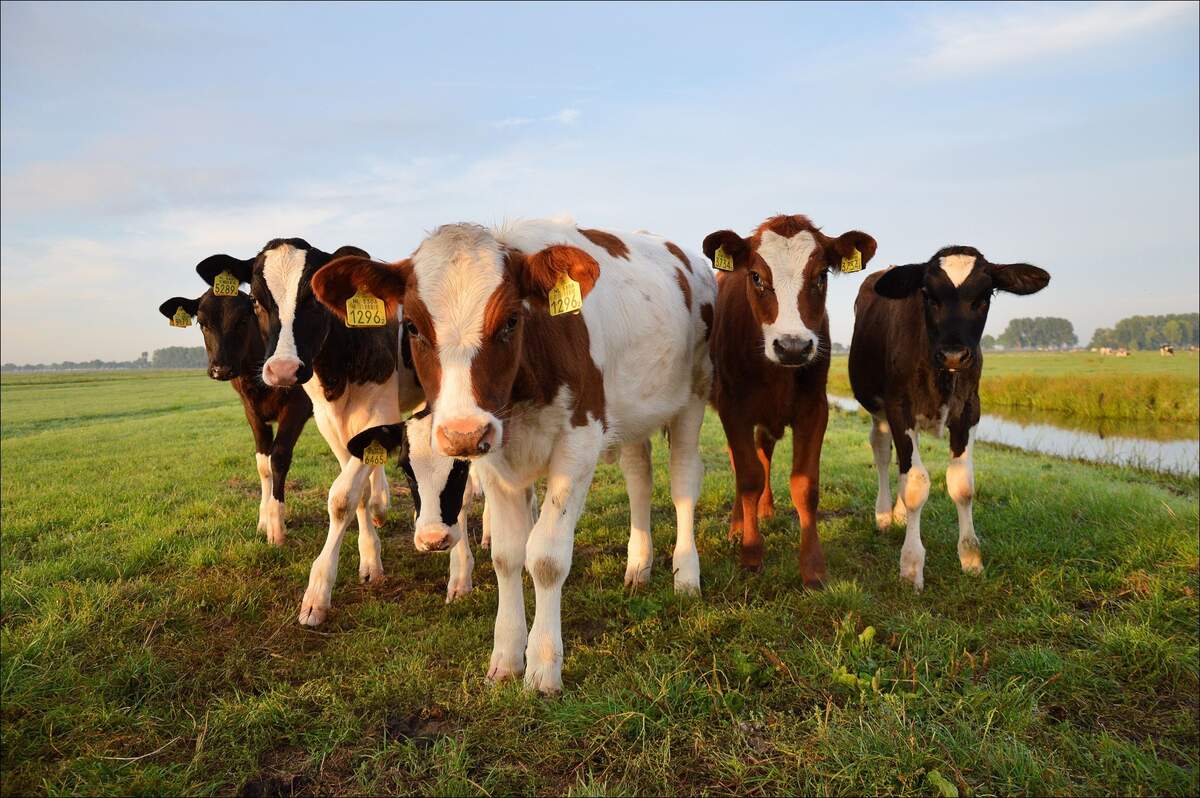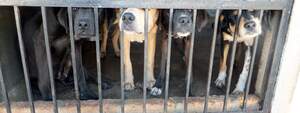

National Farm Animals Day
Observed
annually on April 10th (since 2005)
Dates
Founded by
Colleen Paige in 2005
Hashtags
Sources
https://mountainlake.org/moooo-ve-over-for-national-farm-animals-day/
https://www.britannica.com/animal/livestock
https://www.facebook.com/farmanimalsday/
https://www.holidayguild.com/farm-animals-day
https://www.humanesociety.org/news/facts-about-factory-farms
https://www.humanesociety.org/resources/how-decipher-food-labels
National Farm Animals Day celebrates the joy that farm animals bring, raises awareness about the plight of farm animals, and promotes the need for animal adoption. Farm animals generally include livestock like cattle, sheep, goats, pigs, horses, mules, and donkeys, as well as poultry like chickens, and depending on the region, may extend to buffalo, oxen, camels, and llamas.
Chickens, the largest group of farm animals worldwide, are raised for their eggs and their meat. Cattle, the second largest group, are used for beef production and dairy. Angus, Hereford, and Shorthorn are leaders in beef production, while Jersey, Guernsey, Brown Swiss, Holstein-Friesian, and Ayrshire are prominent breeds for dairy. Cattle are sometimes also used as draft animals, mainly in small-scale farming and in less developed regions.
Sheep were one of the first domesticated animals, having been raised by humans since around 10,000 BCE, and there are over 200 breeds of them. They are used for the wool of their coats and for their meat, mutton, and lamb. Sometimes their milk is used, too. Goats are similar to sheep and are raised for their meat, hides, wool, and milk. Raised since ancient times, pigs are domestic swine, raised for their meat, called pork. There are over 300 breeds of pigs. In the United States, a domesticated pig over 120 pounds is a hog. Horses are used for farm work, or for riding, such as on large cattle ranches. Donkeys and mules are also used as work animals.
These animals may conjure up idyllic images of small family farms dotting bucolic landscapes, but these are largely memories of yesteryear and not the norm today, which is in part why National Farm Animals Day is needed. Almost all farm animals in the United States live on factory farms, where they exist in small spaces, experience cruel treatment, and are turned into commodities, being "processed" as quickly as possible to provide food for humans. Consequently, almost all meat, dairy products, and eggs that Americans consume are from factory farms.
On these farms, chickens spend their whole lives in an area that is smaller than a standard piece of paper. About five to ten chickens live in each cage, where they can't spread their wings, turn around, perch on branches, or scratch the dirt. Egg-laying chickens produce eggs for about a year and a half in these conditions, until their production dwindles, and they are then slaughtered. Those raised to be eaten are bred to grow rapidly, so they have trouble walking and spend most of their time lying down. Their hearts grow too large, their lungs grow too small, they get sores from sleeping and standing, and have muscle damage from growing so quickly. They reach full size at the young age of 45 days, and they are then slaughtered.
Factory-farmed pigs are taken from their mothers after a few weeks and are slaughtered at about the age of six months. Mother pigs spend a great deal of their time in gestation crates, barely being able to move their bodies, being prevented from rooting in the mud and socializing. Similar conditions beleaguer cattle. Calves are taken from their mothers on the day they are born. Mother cows are forced into pregnancy so they produce milk—for calves who won't receive it and who they won't see again.
However, a small portion of farms do function using more humane conditions. Food labels, using varying degrees of standards, indicate to consumers which animal products on the shelves came from such farms. Some labels are more credible than others. To be considered Certified Humane, animals must never be in crates or cages. To get the stamp, there are standards set for the minimum amount of space allowed, the type of bedding material used, and the use of environmental enrichment materials such as hay bales and pecking blocks and perches for chickens. To confirm adherence, inspections are made by auditors.
The Global Animal Partnership has a series of levels reflective of care for animals and nutrition. The first level prohibits cages, crates, and crowding. There must be additional environmental enrichment to reach level two. Level three includes seasonal outdoor access, level four is for pasture-raised animals, and there are additional requirements to reach levels 5 and 5+. Auditors inspect conditions each year to determine levels.
To be considered USDA Organic, animals must get some outdoor access, eat organic feed, and not be given hormones or routine antibiotics. This certification does not include explicit animal welfare requirements beyond this. To be labeled USDA Certified Grass Fed, animals must have continuous outside access during the growing season and only eat grass and forage. (They may also have milk before being weaned.) There aren't any guidelines about how they are to be confined during times of the year outside of the growing season, nor other animal welfare requirements.
Pasture-raised animals have continuous outdoor access when they are growing, but the term doesn't set standards for how much space there must be, or what the quality of the land must be. Other aspects of animal welfare also aren't addressed. Free-range animals are defined as animals who have access to the outdoors for at least half of their lives. There aren't standards provided for the amount of space, frequency of how often the outdoor access must be provided, and the quality of the land. These animals can't be kept in cages or crates, but there aren't guidelines for other aspects of animal welfare.
Cage-free hens are hens that have access to perches and nest boxes and can move around freely indoors—they are housed in indoor, crowded spaces, but can spread their wings, lay eggs in nests, and fly to roosts off the ground at night. The amount of space they are given is undefined unless they also have a seal such as Animal Welfare Approved, Certified Humane, United Egg Producers, or Global Animal Partnership.
There are a number of other labels. Vegetarian-fed indicates that the feed that the animal ate was free of animal products. Hormone-Free, rBGH-Free, rBST-Free, and No Hormones Added means cows weren't given artificial hormones to increase their milk production. "Humanely raised" doesn't have much relevance because it is not defined by the USDA, and "natural" and "naturally raised" are not related to how animals are raised but to agriculture.
The above labels give some indication of the plight of farm animals, which helps understand National Farm Animals Day—a day that celebrates the joy farm animals bring, raises awareness about the plight they face, and promotes the need for animal adoption.
How to Observe National Farm Animals Day
- Visit a family farm.
- Buy meat, eggs, and dairy products from a local farmer who raises their animals in humane conditions. Buy the food at their farm or at a farmers market.
- If you are buying meat, eggs, or dairy products at a supermarket, look for Certified Humane or Global Animal Partnership labels.
- Join a CSA.
- Increase the amount of plant-based foods you eat, participate in Meatless Monday, or become a vegetarian or vegan.
- Join, donate to, or support an organization like United Poultry Concerns, Mercy For Animals, the Humane Society of the United States, or Farm Aid.
- Share with others about the plight that farm animals face.
- Adopt a farm animal.
- Watch a documentary such as Food, Inc..
- Read a book about factory farms.





















